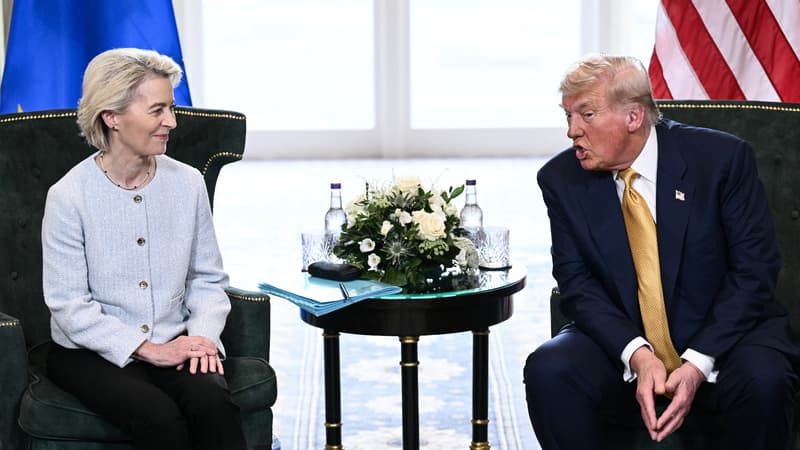The European Union and the United States sealed on Sunday in Scotland “the most important trade agreement” never carried out, according to US President Donald Trump and the president of the European Commission, Ursula von der Leyen.
The stake was in size. The two main commercial powers on the planet exchange almost 4.4 billion euros in goods and services every day, and Washington threatened to impose customs tariffs on August 1 in all European imports. However, France has deplored an “unbalanced” agreement.
This is what we know, for the moment, of this new commercial “agreement” concluded with Donald Trump, after Japan or the Philippines a few days ago.
• What does the agreement provide?
Negotiated fiercely for months, the agreement establishes customs tariffs on all European imports to the United States, at a single rate of 15%, including all existing taxes. This refers, for example, the automotive sector, crucial for countries such as Germany. European manufacturers have paid customs duties of 27.5% since April, including a 25% surcharge decided by Donald Trump, a cost of 1.3 billion euros for German manufacturer Volkswagen.
The agreement also establishes purchases of US hydrocarbons (natural gas, nuclear fuels and oil companies) worth $ 750 billion in three years, or 250 billion per year. For the European Union, this will replace Russian gas imports and to avoid financing the war launched by the Kremlin in Ukraine.
It also includes new European investments in the United States for an amount of $ 600 billion. The US president spoke of “hundreds of billions of dollars” of European armaments.
• 15% exemptions
When asked about these exemptions, the US President replied: “Essentially, no.” But the president of the European Commission said there would be no customs right in “strategic sectors” such as aeronautics, “certain chemical products, certain agricultural products” or “certain strategic raw materials.” However, the list of these products was not detailed.
Europeans also wanted to include alcohol and wine, but due to lack of final agreement, a decision was sent to new discussions, according to Ursula von der Leyen. “This is something that must be resolved in the next few days,” he said.
• Special cases
The negotiations were particularly difficult with respect to the pharmacy and the semiconductors. The final agreement establishes, according to the EU, customs taxes established in 15% for these two sectors. The latter were threatened with greater customs duties, around 200% according to Donald Trump, in accordance with article 232 of an American commercial law that provides a surcharge in case of national security participation.
A decision must be made in two weeks, according to the United States Secretary of Commerce, Howard Lutnick, but for Mrs. von der Leyen, it will not have an impact on the 15% agreement concluded in Scotland.
Currently, the EU faces 50% of customs duties in its steel exports to the United States, but Mrs. von der Leyen said that a commitment to Donald Trump had been found. “Among us, customs duties will be reduced and a quota system will be established,” he said. Donald Trump, on the other hand, said things would remain “as they are.”
• What is happening now?
This is essentially a framework agreement, according to Ursula von der Leyen, which will now require more negotiations to achieve a final legal agreement.
European industrialists and farmers will also dissect the agreement to evaluate their sectoral consequences. German chemistry has already reacted considering customs tasks that affect it “too high”, and the German industry federation (BDI) predicts “considerable negative repercussions.”
Source: BFM TV


